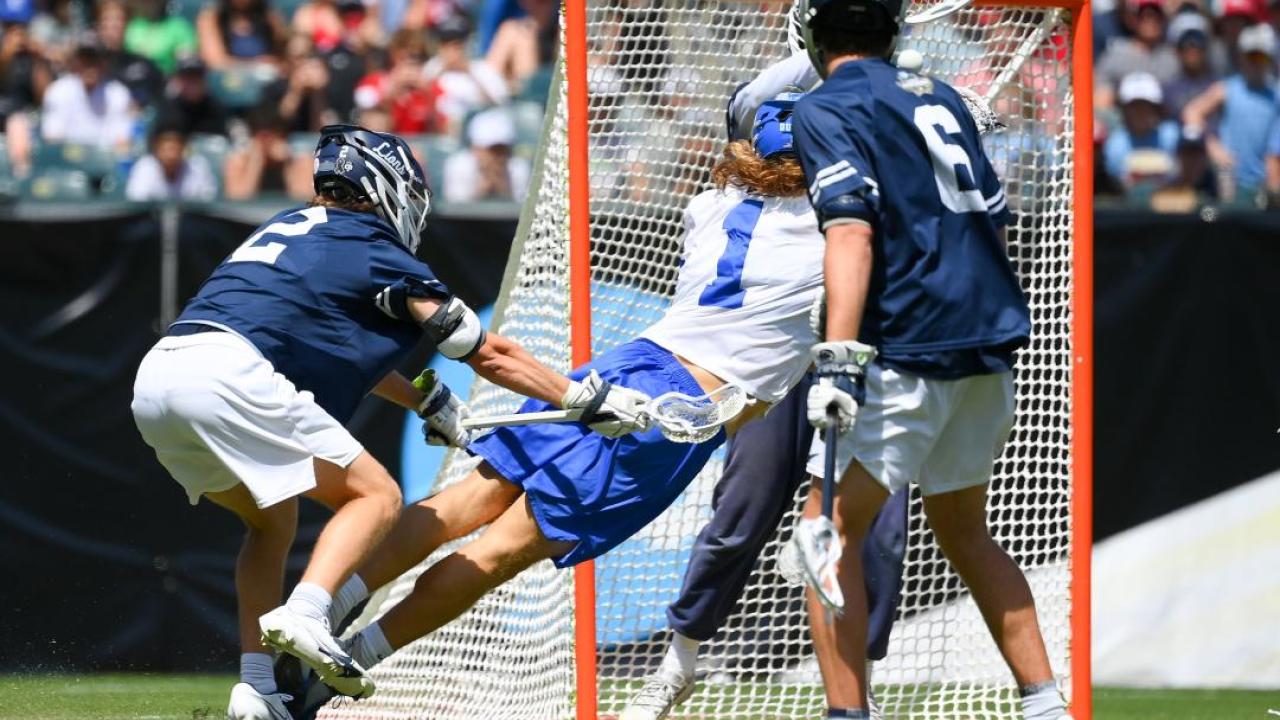
NCAA Men's Lacrosse Rules Committee Proposes Expanded Use of Replay
The NCAA men’s lacrosse rules committee proposed this week a rule change that would expand the use of video replay to include coaches’ challenges for all competitions — not just NCAA championships — and make several additional plays reviewable for the 2023-24 academic year.
All rule proposals must be approved by the Playing Rules Oversight Panel, which is scheduled to discuss men's lacrosse rules recommendations July 19.
If approved, a coach could use a challenge until the last four minutes of regulation, referee discretion could be used at any time during the game and the following plays could be added to the list of reviewable plays:
-
To determine if a loose ball crosses the goal line.
-
To determine if the ball was in the goal before the dislodgment of the goal cage.
-
To determine if an offensive player was in or landed in the crease before the ball entered the goal.
-
To determine if an offensive player landed in the goal mouth as a result of illegal contact by the defense before the ball entered the goal.
-
To determine if a goal was scored as a result of the head of the shooter's crosse coming off during the shot or follow-through.
Currently, the only reviewable scenarios during the NCAA championships are:
-
To correct the game and/or shot clock when there is a malfunction or timing error.
-
To determine if the release of a shot at the end of a period came before the expiration of time for the game clock or the shot clock.
-
To determine if a shot at the end of a period was deflected off a defensive or offensive player before it entered the goal.
-
To determine if a shot hit the camera mounted inside the goal cage.
This would seem to be a response to the controversial ending to the NCAA Division I semifinal between Duke and Penn State. The Blue Devils prevailed 16-15 in overtime on a goal by Garrett Leadmon, who replay showed clearly stepped on the edge of the crease with his right foot before diving in front of the goal mouth to score.
The play was not reviewable. Duke advanced to the NCAA championship game, falling to Notre Dame 13-9.
A week earlier, the Nittany Lions were the beneficiary of replay when video review determined Army’s Jacob Morin fired a shot into the net after time expired and Penn State escaped with a 10-9 NCAA quarterfinal victory.
Also under the proposal, a team would be permitted two team timeouts and one coach's challenge each half, while maintaining one timeout during any overtime period.
If a coach's challenge is unsuccessful, that team would be charged a timeout and lose its challenge for that half. If the challenge is successful, the team would retain that timeout and coach's challenge.
Should a team no longer have any timeouts remaining in a half, a coach could not challenge a call on the field.
A coach's challenge could only be requested for the reviewable items. Challenges would not carry over.
All reviews in the last four minutes of regulation or any overtime period would be reviewed at the referee's discretion.
A coach would have 30 seconds to challenge a nongoal play. If there is not an imminent scoring opportunity, the officials would stop play as soon as possible to conduct a review.
If the challenging team or the opposing team scores a goal during that time, the goal would not be counted if it is determined that the reviewable nongoal play was a goal.
Additionally, contact to the head and/or neck area may be reviewed only if the on-field official makes an original call that potential contact to the head and/or neck area has occurred.
Officials will notify coaches before starting the review, and they would have three penalty options to consider under this review:
-
Indirect contact to the head and/or neck area.
-
Direct contact to the head and/or neck area.
-
Excessive or flagrant contact to the head and/or neck area with possible expulsion.
Officials would be permitted to review a possible infraction that was not observed during play; however, only contact to the head and/or neck area may be considered.
Should the officials determine that another infraction occurred, they may not assess that penalty by video review. However, if the officials determine that contact to the head and/or neck area did occur, they could enforce those penalties under this proposed rule.
HELMETS
The committee proposed that any time a player's helmet comes off during a live ball scenario, the officials would stop play immediately.
The player would be required to leave the field of play. Play would restart once the player reaches the sidelines. The player would not be allowed back on the field until the next dead ball after the restart of play.
USA Lacrosse Staff
Categories
Tags
Related Articles




